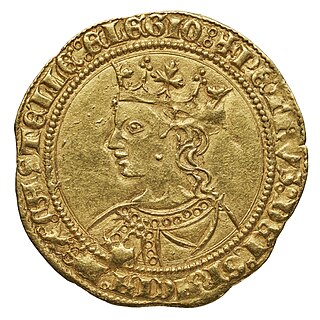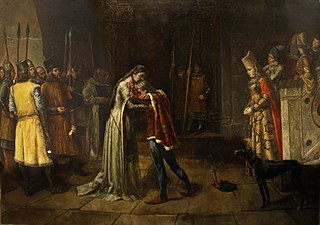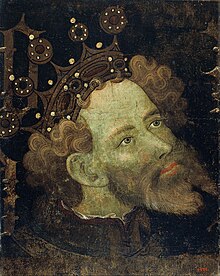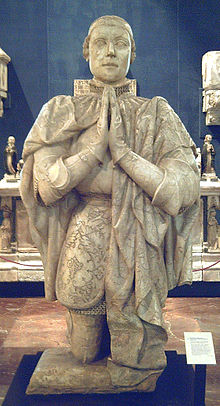
Peter, called Peterthe Cruel or the Just, was King of Castile and León from 1350 to 1369. Peter was the last ruler of the main branch of the House of Ivrea. He was excommunicated by Pope Urban V for his persecutions and cruelties committed against the clergy.

Ferdinand I, sometimes called the Handsome or occasionally the Inconstant, was the King of Portugal from 1367 until his death in 1383. He was also briefly made King of Galicia, in 1369. Facing a lack of legitimate male heirs, his death led to the 1383–85 crisis, also known as the Portuguese interregnum.

Henry II, called Henry of Trastámara or the Fratricidal, was the first King of Castile and León from the House of Trastámara. He became king in 1369 by defeating his half-brother Peter the Cruel, after numerous rebellions and battles. As king he was involved in the Fernandine Wars and the Hundred Years' War.

Fadrique Alfonso of Castile, 1st Señor de Haro (1334–1358), 25th Master of the Order of Santiago (1342–1358), was the fifth illegitimate child of Alfonso XI of Castile and Eleanor of Guzman. He was born in Seville.

The Battle of Nájera, also known as the Battle of Navarrete, was fought on 3 April 1367 to the northeast of Nájera, in the province of La Rioja, Castile. It was an episode of the first Castilian Civil War which confronted King Peter of Castile with his half-brother Count Henry of Trastámara who aspired to the throne; the war involved Castile in the Hundred Years' War. Castilian naval power, far superior to that of France or England, encouraged the two polities to take sides in the civil war, to gain control over the Castilian fleet.

The Battle of Montiel was fought on 14 March 1369 between the Franco-Castilian forces supporting Henry of Trastámara and the Granadian-Castilian forces supporting the reigning Peter of Castile.

The House of Trastámara was a royal dynasty which first ruled in the Crown of Castile and then expanded to the Crown of Aragon in the late middle ages to the early modern period.

The Crown of Castile was a medieval polity in the Iberian Peninsula that formed in 1230 as a result of the third and definitive union of the crowns and, some decades later, the parliaments of the kingdoms of Castile and León upon the accession of the then Castilian king, Ferdinand III, to the vacant Leonese throne. It continued to exist as a separate entity after the personal union in 1469 of the crowns of Castile and Aragon with the marriage of the Catholic Monarchs up to the promulgation of the Nueva Planta decrees by Philip V in 1715.

The Castilian Civil War was a war of succession over the Crown of Castile that lasted from 1351 to 1369. The conflict started after the death of king Alfonso XI of Castile in March 1350. It became part of the larger conflict then raging between the Kingdom of England and the Kingdom of France: the Hundred Years' War. It was fought primarily in Castile and its coastal waters between the local and allied forces of the reigning king, Peter, and his illegitimate brother Henry of Trastámara over the right to the crown.
The Treaty of Torrellas, signed in Torrellas on 8 August 1304, settled the question of conquest of the Kingdom of Murcia, thitherto a dependency of the Crown of Castile, by James II of Aragon. The agreement favored the Crown of Aragon, straining ties.

The Infantes of Aragon is an appellation commonly used by Spanish historians to refer to a group of 15th-century infantes (princes) of the House of Trastámara, specifically the sons of King Ferdinand I of Aragon and his wife Eleanor of Alburquerque:
The Battle of Barcelona was a naval engagement fought in the coastal region of Barcelona, Catalonia, Spain, between the navies of the Crowns of Aragon and Castile, during the War of the Two Peters. A number of months beforehand, a large Castilian fleet had been assembled at Seville by order of the King of Castile, Peter I. Consisting of 128 warships including royal vessels, ships from the King of Castile's vassals, and several others that had been sent by the Castilian-allied monarchs of Portugal and Granada, this large fleet had been entrusted to the Genoese admiral, Egidio Boccanegra, who was seconded by two of his relatives, Ambrogio and Bartolome.

The Battle of Araviana was a cavalry action fought during the War of the Two Peters on 22 September 1359. Eight hundred Aragonese horse, many of them Castilian exiles in service of the Crown of Aragon under Henry of Trastámara, had launched a cavalgada in Castilian territory when, near the Castilian town of Ágreda, confronted and routed a Castilian force under Juan Fernández de Henestrosa set to guard the frontier. Numerous Castilian noblemen and knights were killed, including Henestrosa, while many other were captured.
Coming to power in 1369, the House of Trastámara was a lineage of rulers of the Castilian and Aragonese thrones. The line of Trastámaran royalty in Castile ruled throughout a time period of military struggle with Aragon. Their family was sustained with large amounts of inbreeding, which led to a series of disputed struggles over rightful claims to the Castilian throne. This lineage ultimately ruled in Castile from the rise to power of Henry II in 1369 through the unification of the crowns under Ferdinand and Isabella.
Diego García de Padilla was a Spanish nobleman who became Master of the Order of Calatrava. His sister María de Padilla was the wife of King Peter of Castile, the Cruel. Padilla fought for Peter of Castile in the wars against Aragon and Granada. In the Castilian Civil War (1366–69) he went over to the side of Henry of Trastámara.

The Castilian House of Ivrea, also known as the House of Burgundy, is a cadet branch of the House of Ivrea descended from Raymond of Burgundy. Raymond married Urraca, the eldest legitimate daughter of Alfonso VI of León and Castile of the House of Jiménez. Two years after Raymond's death, Urraca succeeded her father and became queen of Castile and León; Urraca's and Raymond's offspring in the legitimate line ruled the kingdom from 1126 until the death of Peter of Castile in 1369, while their descendants in an illegitimate line, the House of Trastámara, would rule Castile and Aragón into the 16th century.

Peter of Aragon was an infante of the Crown of Aragon who served three successive kings as a soldier, diplomat and counsellor before joining the Franciscans in 1358.
The Treaty of Libourne was signed at Libourne on 23 September 1366 between King Peter I of Castile, Edward the Black Prince, heir to the English crown, and King Charles II of Navarre. It led to the English involvement against France in the Castilian Civil War as part of the Hundred Years War.

The Castilian Civil War of 1437–1445 was a civil war in which two noble factions fought for power in the Crown of Castile. On one side was Constable Álvaro de Luna, King John II of Castile, and Henry Prince of Asturias. On the other side was the noble League led by Infantes of Aragon John and Henry, sons of Ferdinand of Antequera, who was the regent of Castile during the minority of John II. Although the Infantes of Aragon faction won in 1441, imposing their conditions in the Medina del Campo ruling, the final victory went to the royalist faction and the Constable, who won the decisive battle of Olmedo. According to historian Carme Batlle, Álvaro de Luna is primarily responsible for the war. Following his victory over the Infantes of Aragon during the truces of Majano, Luna's "authoritarian excesses" escalated and led to a civil war. Although Batlle places the war's start in 1439.














